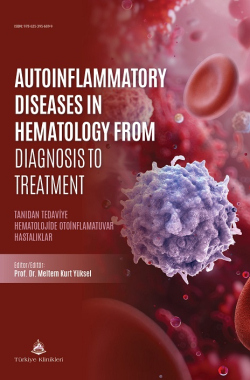MONOGENEIC INFLAMMATORY DISORDERS
INTRODUCTION
Autoinflammatory diseases (AIDs) represent a distinct group of disorders characterized by dysregulated innate immune system responses, leading to uncontrolled inflammation without an evident infectious or autoimmune trigger.1 These conditions, which are primarily driven by genetic mutations affecting key inflammatory pathways, have increasingly been recognized for their impact on various medical specialties, including hematology (PubMed, 2023).2
One such example of AIDs accompanied by hematologic manifestations is VEXAS (vacuoles, E1 enzyme, X-linked, autoinflammatory, somatic) syndrome. VEXAS syndrome was identified in 2020 and mutations in ubiquitin activating enzyme 1 (UBA1) were detected in three patients by whole exome sequencing performed in 2,560 patients. This causative mutation is acquired later in life as a somatic mutation and can only be identified through next-generation sequencing (NGS) gene analysis.3 Another disease in this group, GATA2 deficiency, is an autosomal dominantly inherited germline disorder that causes a broad spectrum of phenotypes, including viral and bacterial infections, cytopenias, myelodysplasia, myeloid leukemias, pulmonary alveolar proteinosis and lymphedema. Many different germline GATA2 mutations (missense, nonsense, deletion) have been reported.4 Since GATA2 deficiency involves germline mutations, diagnostic approaches should consider methods beyond NGS, including techniques capable of detecting coy number variations (CNVs). Selecting the most appropriate genetic testing method is crucial for accurately detecting the mutation.
The interplay between autoinflammation and hematologic abnormalities underscores the necessity for a multidisciplinary approach to diagnosis and management. Advances in genetic testing and molecular diagnostics have significantly improved our ability to identify these disorders early, allowing for more precise classification and targeted therapeutic strategies.
This book chapter aims to provide a comprehensive overview of autoinflammatory diseases in the context of hematology, from pathophysiology and genetic underpinnings to clinical presentation, diagnosis, and treatment modalities. Recent developments in biologic therapies targeting key inflammatory mediators, such as interleukin-1 (IL-1) and interleukin-6 (IL-6), have revolutionized the management of these disorders, offering patients improved outcomes and quality of life.2 However, challenges remain in early recognition, differential diagnosis, and long-term disease monitoring.
By integrating the latest research findings with clinical practice, this chapter will serve as a valuable resource for clinicians, researchers, and healthcare professionals involved in the care of patients with autoinflammatory conditions affecting hematologic function. Understanding the intricate relationship between innate immunity and hematologic disease is essential for advancing diagnostic accuracy and optimizing therapeutic interventions in this evolving field.
Assoc. Prof. Dr. Nüket Kutlay
Ankara University, Faculty of Medicine,
Department of Medical Genetic,
Ankara, Türkiye
Referanslar
- Broderick L, Hoffman HM. IL-1 and autoinflammatory disease: biology, pathogenesis and therapeutic targeting. Nat Rev Rheumatol. 2022;18(8):448-463. [Crossref] [PubMed] [PMC]
- Henrie R, Cherniawsky H, Marcon K, et al. Inflammatory diseases in hematology: a review. Am J Physiol Cell Physiol. 2022;323(4):C1121-C1136. [Crossref] [PubMed]
- Al-Hakim A, Savic S. An update on VEXAS syndrome. Expert Rev Clin Immunol. 2023;19(2):203-215. 6x.2023.2157262 [Crossref] [PubMed]
- Hsu AP, McReynolds LJ, Holland SM. GATA2 deficiency. Curr Opin Allergy Clin Immunol. 2015;15(1):104-109. aci.0000000000000126 [Crossref] [PubMed] [PMC]

